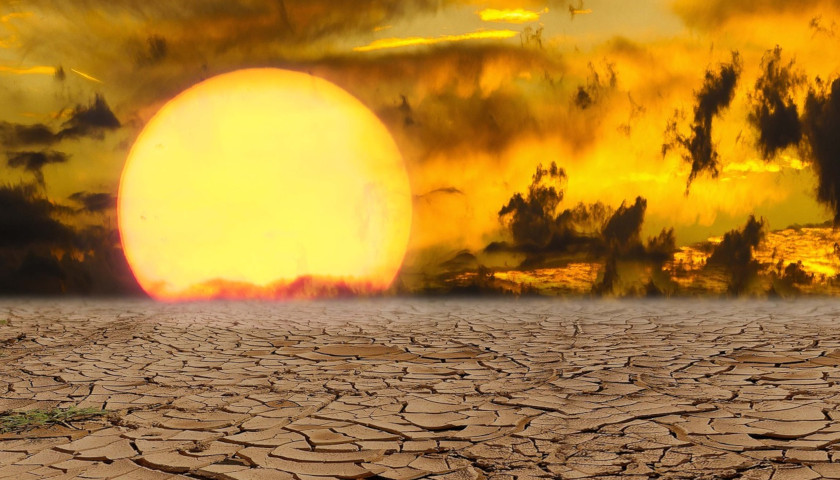At a recent United Nations summit, 16-year-old activist Greta Thunberg claimed that the Earth is on the brink of destruction and that older generations are betraying younger ones by not doing enough to stop climate change. The media has amplified these allegations by giving her speech broad, glowing coverage, but the fears she expressed are not grounded in reality.
The End of Humanity?
Thunberg says that she is “one of the lucky ones” who are not already “dying” from global warming and claims that with “today’s emissions levels our remaining CO2 budget will be gone in less than 8.5 years.” She frets that if we exceed this so-called budget, we risk “setting off irreversible chain reactions beyond human control.”
Such apocalyptic beliefs are common among young people. A recent Scott Rasmussen/HarrisX poll found that 51% of U.S. voters under the age of 35 believe it is “somewhat likely” or “very likely” that the “the earth will become uninhabitable and humanity will be wiped out” in “the next 10–15 years.”
Thunberg says her fears are justified by “more than 30 years” of “crystal-clear” science, but as detailed below, just the opposite is true. Contrary to predictions made three decades ago, a broad range of environmental and human welfare indicators related to the effects of climate change have stayed level or improved. Yet, in accord with a stratagem published at the outset of this period, many people are unaware of this.
“Getting Loads of Media Coverage”
Exactly 30 years ago in 1989, climatologist Stephen Schneider—the creator of the journal Climatic Change and one of the founding members of the UN’s Intergovernmental Panel on Climate Change (IPCC)—told Discover magazine that in order to “reduce the risk of potentially disastrous climate change”:
We have to get some broad-based support, to capture the public’s imagination. That, of course, entails getting loads of media coverage. So we have to offer up scary scenarios, make simplified, dramatic statements, and make little mention of any doubts we might have. This “double ethical bind” which we frequently find ourselves in cannot be solved by any formula. Each of us has to decide what the right balance is between being effective and being honest. I hope that means being both.
Despite his willingness to tell half-truths and compromise honesty for the sake of “being effective,” Schneider, along with his IPCC colleagues and Al Gore, was awarded a Nobel Peace Prize in 2007 for “efforts to build up and disseminate greater knowledge about man-made climate change….”
In 1989, the same year that Schneider laid out his plan and when Thunberg says the clear scientific record began, high-ranking UN officials and EPA scientists predicted ruinous effects from global warming unless timely actions were taken to prevent it. These include projections about plants, forests, extinctions, agriculture, flooding, rainfall, hurricanes, and human health. Comparing these forecasts to the actual outcomes—or crystal-clear science—is revealing.
Plant Life
In 1989, William H. Mansfield III, the deputy executive director of the United Nations Environment Programme, wrote that “global warming may be the greatest challenge facing humankind,” and “any change of temperature, rainfall, and sea level of the magnitude now anticipated will be destructive to natural systems” like “plant” life.
In reality, a 2016 paper in the journal Nature Climate Change examined three long-term satellite datasets and found “a persistent and widespread increase” in “greening” or plant growth “over 25% to 50% of the global vegetated area” from 1982 to 2014, “whereas less than 4% of the globe” had less greening over this period.
Those findings support and update a 2003 paper in the journal Science, which found that a principal measure of worldwide vegetation productivity increased by 6.2% between 1982 and 1999. The authors note that this occurred during a period in which human population increased by 37%, the level of atmospheric CO2 increased by 9%, and the Earth “had two of the warmest decades in the instrumental record.”
Forests & Trees
In the same 1989 article, Mansfield claimed that “forests would be adversely affected” by global warming.
In contrast, reports published by the United Nations Food and Agriculture Organization from 2015 through 2018 found that the mass of above-ground organic plant materials in forests “has remained stable since the 1990s” and “most regions of the world are experiencing either positive or small-to-no changes in forest area or above-ground biomass.”
More significantly, the journal Nature published a study in 2018 that analyzed satellite data to obtain “a comprehensive record of global land-change dynamics” from 1982 to 2016. It found that tree cover increased by 7.1% during this period, with the margins of error ranging from a 2.9% to 10.8% rise with 90% confidence.
Extinctions
In 1989, Sandra Henderson, a biogeographer at EPA’s Environmental Research Laboratory, wrote that “scientists are warning of a possible loss of 20 percent of the earth’s species before the end of the century,” and “a major factor in this modern species extinction may be our alteration of the earth’s climate: global warming due to increased concentrations of greenhouse gases.”
Given that roughly 1.2 million species have been cataloged, a loss of 20% would be 240,000 species.
Yet, during 1984–2004, the International Union for Conservation of Nature recorded 27 confirmed species extinctions. This is not an exact figure, as the report notes that other extinctions may have occurred, such as “eight species of birds.” Regardless of the precise number, the actual loss was orders of magnitude below the projected one and in line with the average historical extinction rate.
Likewise, a 2011 paper in the journal Diversity and Distributions notes that extinctions mainly occur on islands where populations are small and tightly restricted by physical boundaries. Thus, the paper analyzed continental extinctions and found only six confirmed extinctions of continental birds and three confirmed extinctions of continental mammals since the year 1500. These figures amount to 0.08% of continental mammals and 0.062% of continental birds.
Despite these facts, people have led Thunberg to believe that “entire ecosystems are collapsing,” and “we are in the beginning of a mass extinction.”
Agriculture
Mansfield also wrote in 1989 that “food supplies” would be negatively impacted and “changes in rainfall patterns would disrupt agriculture.”
In actuality, the United Nations Food and Agriculture Organization reported in 2003 that food consumption per person increased by 15% worldwide and 25% in developing countries between the mid-1970s and late 1990s.
 Continuing this trend, UN data from 2000 to 2015 shows that the portion of the world population that was undernourished decreased from 15% to 11%:
Continuing this trend, UN data from 2000 to 2015 shows that the portion of the world population that was undernourished decreased from 15% to 11%:
Moreover, the severity of undernourishment for the malnourished has declined. From 1992 to 2016, while global population increased by 36%, the average number of calories needed to lift all the undernourished people of the world out of that condition decreased from 172 to 88 calories per person:
Flooding
In 1989, the Associated Press reported: “A senior U.N. environmental official says entire nations could be wiped off the face of the Earth by rising sea levels if the global warming trend is not reversed by the year 2000. Coastal flooding and crop failures would create an exodus of ‘eco- refugees,’ threatening political chaos, said Noel Brown, director of the New York office of the U.N. Environment Program.”
Similarly, Mansfield wrote in 1989: “Sea-level rise as a consequence of global warming would immediately threaten that large fraction of the globe living at sea level. … Most of the world’s great seaport cities would be endangered: New Orleans, Amsterdam, Shanghai, Cairo. Some countries-the Maldives Islands in the Indian Ocean, islands in the Pacific-would be inundated. Heavily populated coastal areas such as in Bangladesh and Egypt, where large populations occupy low-lying areas, would suffer extreme dislocation.”
 In reality, a study of satellite data published by the journal Nature Climate Change in 2016 found that from 1985 to 2015, the net amount of land area on Earth grew by about 22,400 square miles, and the net amount of coastal land grew by about 5,200 square miles.
In reality, a study of satellite data published by the journal Nature Climate Change in 2016 found that from 1985 to 2015, the net amount of land area on Earth grew by about 22,400 square miles, and the net amount of coastal land grew by about 5,200 square miles.
Increases in land area and/or human population have also occurred in places that are considered to be highly vulnerable to rising sea levels. This includes Pacific island nations like Kiribati and Tuvalu, Bangladesh, and Florida’s coastal areas.
This is not to say that the average global sea level isn’t rising. This has been happening since 1860 or earlier, which is about 45 years before surface temperatures began to rise and 75 years before man-made emissions of carbon dioxide reached 1% of natural emissions. However, the trends and effects have been nothing like climate doomsayers have predicted.
Rainfall
Again in 1989, Dr. David Rind, an atmospheric scientist at the Goddard Institute for Space Studies and a “leading researcher” on global warming, wrote that his agency’s “model’s forecast for the next 50 years” predicts an average global temperature increase of “3.6ºF by the year 2020.” As a result, he said that “rainfall patterns would likely be substantially altered, posing the threat of large-scale disruptions of agricultural and economic productivity, and water shortages in some areas.”
As it turned out, Earth’s average global temperature increased by about 0.7ºF between the 1980s and 2010s, or by one-fifth of this projection.
 With regard to rainfall, a 2015 paper in the Journal of Hydrology examined rainfall measurements “made at nearly 1,000 stations located in 114 countries” and found “no significant global precipitation change from 1850 to present.” The paper notes that previous studies had analyzed shorter timeframes and found rainfall changes that some people had attributed to global warming, but those results were generally not statistically significant and “not entirely surprising given that precipitation varies considerably over time scales of decades.”
With regard to rainfall, a 2015 paper in the Journal of Hydrology examined rainfall measurements “made at nearly 1,000 stations located in 114 countries” and found “no significant global precipitation change from 1850 to present.” The paper notes that previous studies had analyzed shorter timeframes and found rainfall changes that some people had attributed to global warming, but those results were generally not statistically significant and “not entirely surprising given that precipitation varies considerably over time scales of decades.”
Regarding drought, a 2013 paper in the journal Theoretical and Applied Climatology found that contrary to “climate models,” actual observations “reveal no significant trend in the areas under drought over land in the past three decades.” The study did find increasing drought over land in the Southern Hemisphere, but the hemisphere is only 19% land, as opposed to 39% in the Northern Hemisphere. The trend is also well within the bounds of short-term variability, as shown in this chart from the paper:
Hurricanes
Mansfield also wrote in 1989 that “warmer oceans would spawn stronger hurricanes and typhoons, resulting in coastal flooding, possibly swamping valuable agricultural lands around the world.”
Actual outcomes show nothing of the sort. As far back in time as reliable data exists, global hurricane frequency, intensity, and duration have all been level. Comprehensive global datasets on hurricane frequency and intensity, which were published by the journal Geophysical Research Letters in 2011 and updated in 2018, show roughly flat trends for the past four-to-five decades.
Likewise, the IPCC reported in 2012: “There is low confidence in any observed long-term (i.e., 40 years or more) increases in tropical cyclone activity (i.e., intensity, frequency, duration), after accounting for past changes in observing capabilities.” This also applies to hurricanes, which are tropical cyclones with winds exceeding 73 miles per hour.
Highlighting how people have been misled about this issue, a national scientific survey commissioned by Just Facts in 2018 found that 66% of U.S. voters believe that the global “number and intensity of hurricanes and tropical storms have generally increased since the 1980s,” including 91% of Democrats and 40% of Republicans.
Human Health
Mansfield also wrote in 1989: “Human health would be affected. Warming could enlarge tropical climate bringing with it yellow fever, malaria, and other diseases.”
Populations of disease-carrying insects have grown dramatically over the past several decades, but as multiple studies have shown, there is no reliable evidence that climate change is the reason. Instead, another factor is the probable cause.
As documented in a 2016 study of coastal U.S. mosquito populations in the journal Nature Communications, increases in U.S. mosquito populations don’t correspond with rising temperatures but with decreasing residues of the pesticide DDT. This occurred because governments restricted and banned DDT at the behest of environmental activists.
The World Health Organization and some environmental organizations now endorse using DDT inside of homes to combat malaria. Other environmental groups still insist that it harms human health, even though a 2000 article in the British Medical Journal reported that there is “not even one peer reviewed, independently replicated study linking exposure to DDT with any adverse health outcome.”
Likewise, a 2012 paper in the medical journal Lancet about insect-borne diseases explains that “climate has not consistently changed in the right way, at the right time, and in the right places to account for the” changes in vector-borne diseases. The paper also notes that “a persistent stream of reviews are published that claim that climate change is a primary driving force.” This incessant misreporting fits with Schneider’s marching orders to “offer up scary scenarios, make simplified, dramatic statements, and make little mention of any doubts we might have.”
Tipping Points
Despite the fact that these decades-old predictions of climate catastrophes have yet to materialize, some claim they are just around the corner. Thunberg, for instance, says that people don’t “fully” understand the “urgency” of the situation and that “cutting our emissions in half in 10 years only gives us a 50% chance of staying below 1.5C degrees, and the risk of setting off irreversible chain reactions beyond human control.”
Such assertions are strikingly similar to those made thirty years ago. The Associated Press reported in 1989 that Brown “said governments have a 10-year window of opportunity to solve the greenhouse effect before it goes beyond human control.”
Thunberg, however, seems to be unaware of the historical record and worries about “tipping points.” A tipping point, as defined by the American Heritage Dictionary of the English Language, is “a critical moment in a complex situation in which a small influence or development produces a sudden large or irreversible change.” While the future is inherently uncertain, the very nature of carbon dioxide impedes that possibility.
That is because the greenhouse effect of additional carbon dioxide—the primary manmade greenhouse gas—declines as its levels increase. This scientific fact is rarely revealed to the public, but as Stephen Schneider himself wrote in the journal Science in 1971: “As more CO2 is added to the atmosphere, the rate of temperature increase is proportionally less and less, and the increase eventually levels off.”
In technical terms, Schneider explains that “the runaway greenhouse effect does not occur because the 15-μm CO2 band, which is the main source of absorption, ‘saturates,’ and the addition of more CO2 does not substantially increase the infrared opacity of the atmosphere.”
Conclusion
According to an article in Time magazine, Thunberg “cited more than 30 years of scientific evidence showing the consequences of a perpetually warming globe.” That is a misleading description of her words. In reality, she merely claimed this was so without presenting any scientific evidence to support it.
To the contrary, a wide array of environmental and human welfare indicators related to climate change have stayed level or improved for the past 30 years. This includes measurable outcomes of plants, forests, extinctions, agriculture, flooding, rainfall, hurricanes, and human health. This is true “crystal-clear” science, and it is at odds with Thunberg’s beliefs.
Legendary physicist Richard Feynman was an extremely creative thinker who blazed new frontiers of science, but he was also a staunch advocate of the view that science must be grounded in practical reality. He expressed this by saying: “The principle of science, the definition, almost, is the following: The test of all knowledge is experiment. Experiment is the sole judge of scientific ‘truth’.”
The real-world experiments of the past 30 years constitute genuine science, while the failed predictions of certain scientists and environmental officials have proven to be the antithesis of science.
In her speech, Thunberg raged that people “have stolen my dreams and my childhood,” which is arguably true. However, she blames the wrong culprits. Her anxiety and desperation are not the fault of adults who act in accord with the facts of this issue. Instead, Thunberg’s tormenters are the people who have indoctrinated her and many other youth with unfounded fears.
– – –
James D. Agresti is the president of Just Facts, a think tank dedicated to publishing rigorously documented facts about public policy issues.




